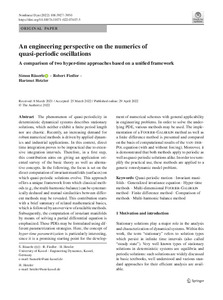| dc.date.accessioned | 2022-08-16T09:39:29Z | |
| dc.date.available | 2022-08-16T09:39:29Z | |
| dc.date.issued | 2022-04-29 | |
| dc.identifier | doi:10.17170/kobra-202206016279 | |
| dc.identifier.uri | http://hdl.handle.net/123456789/14059 | |
| dc.description.sponsorship | Gefördert im Rahmen des Projekts DEAL | ger |
| dc.language.iso | eng | |
| dc.rights | Namensnennung 4.0 International | * |
| dc.rights.uri | http://creativecommons.org/licenses/by/4.0/ | * |
| dc.subject | quasi-periodic motion | eng |
| dc.subject | invariant manifolds | eng |
| dc.subject | generalized invariance equation | eng |
| dc.subject | hyper-time methods | eng |
| dc.subject | multi-dimensional Fourier-Galerkin method | eng |
| dc.subject | finite difference method | eng |
| dc.subject | comparison of methods | eng |
| dc.subject | multi-harmonic balance method | eng |
| dc.subject.ddc | 620 | |
| dc.title | An engineering perspective on the numerics of quasi-periodic oscillations | eng |
| dc.type | Aufsatz | |
| dcterms.abstract | The phenomenon of quasi-periodicity in deterministic dynamical systems describes stationary solutions, which neither exhibit a finite period length nor are chaotic. Recently, an increasing demand for robust numerical methods is driven by applied dynamics and industrial applications. In this context, direct time integration proves to be impractical due to extensive integration intervals. Therefore, in a first step, this contribution aims on giving an application oriented survey of the basic theory as well as alternative concepts. In the following, the focus is set on the direct computation of invariant manifolds (surfaces) on which quasi-periodic solutions evolve. This approach offers a unique framework from which classical methods (e.g., the multi-harmonic-balance) can be systematically deduced and mutual similarities between different methods may be revealed. This contribution starts with a brief summary of related mathematical basics, which is followed by an overview of available methods. Subsequently, the computation of invariant manifolds by means of solving a partial differential equation is emphasized. These PDEs may be formulated using different parametrization strategies. Here, the concept of hyper-time parametrization is particularly interesting, since it is a promising starting point for the development of numerical schemes with general applicability in engineering problems. In order to solve the underlying PDE, various methods may be used. The implementation of a Fourier-Galerkin method as well as a finite difference method is presented and compared on the basis of computational results of the van-der-Pol equation (with and without forcing). Moreover, it is demonstrated that both methods apply to periodic as well as quasi-periodic solutions alike. In order to exemplify the practical use, these methods are applied to a generic rotordynamic model problem. | eng |
| dcterms.accessRights | open access | |
| dcterms.creator | Bäuerle, Simon | |
| dcterms.creator | Fiedler, Robert | |
| dcterms.creator | Hetzler, Hartmut | |
| dc.relation.doi | doi:10.1007/s11071-022-07407-5 | |
| dc.subject.swd | Parametrisierung | ger |
| dc.subject.swd | Endliche Mathematik | ger |
| dc.subject.swd | Finite-Differenzen-Methode | ger |
| dc.subject.swd | Differentialgleichung | ger |
| dc.title.subtitle | A comparison of two hyper-time approaches based on a unified framework | eng |
| dc.type.version | publishedVersion | |
| dcterms.source.identifier | eissn:1573-269X | |
| dcterms.source.issue | Issue 4 | |
| dcterms.source.journal | Nonlinear Dynamics | eng |
| dcterms.source.pageinfo | 3927-3950 | |
| dcterms.source.volume | Volume 108 | |
| kup.iskup | false | |



